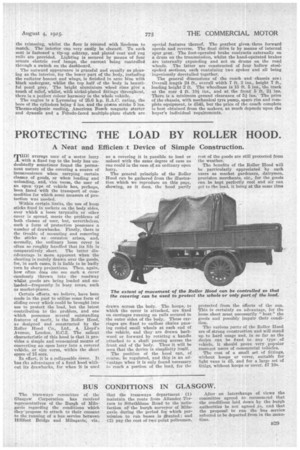PROTECTING THE LOAD BY ROLLER HOOD.
Page 13

If you've noticed an error in this article please click here to report it so we can fix it.
A Neat and Efficien Device of Simple Construction.
T" average user of a motor lorry with a fixed top to the body has undoubtedly sometimes found the permanent nature of the covering a source of inconvenience when carrying certain classes of goods, or when loading and unloading, and, vice versa, the user of an open type of vehicle has, perhaps, been faced with the transport of commodities for which some measure of protection was needed.
Within certain limits, the use of hoop sticks fixed in sockets on the body sides, over which a loose tarpaulin or other cover is spread, meets the problems of both classes of user, hut, nevertheless, such a form of protection possesses a number of drawbacks. Firstly, there is the trouble of mounting and removing the sticks as occasion arises, and, secondly, the ordinary loose cover is often so roughly handled that its life is comparatively short. The latter disadvantage is more apparent when the sheeting is merely drawn over the goods, for, in such cases, it is liable to be badly torn by sharp projections. Then, again, how often does one see such a cover carelessly thrown into the roadway whilst goods are being loaded and mlleaded—frequently in busy areas, such as market-places.
Certain efforts, we believe, have been made in the past to utilize some form of sliding cover which could be brought into use to protect the load, but the latest contribution to the problem, and one which possesses several outstanding features of merit, is the Roller Hood, as designed and constructed by the Roller Hood Co., Ltd., 4, Lloyd's Avenue, ' London, E.C.2. The salient characteristic of this hood is that it provides a simple and economical means of converting an open lorry into a covered vehicle, or vice versa, within the short space of 15 secs.
In effect, it is a collapsable cover. It has the advantages of a fixed hoed without its drawbacks, for when it is used
as a covering it is possible to load or unload with the same degree of ease as one eould in the case of an ordinary open lorry.
The general principle of the Roller Hood can be gathered from the illustration which we reproduce on this page, showing, as it does, the hood partly
drawn across the body. The hoops, to which the cover is attached, are fixed on carriages running on rails secured to the outer sides of. the body. These carriages are fixed to endless chains passing round small wheels at each end of the vehicle, and they are drawn backward or forward by rotating a handle attached to a shaft passing across the front end of the body. Thus it will be seen that the device is simplicity itself.
The position of the hood can, of course, be regulated, and this is an advantage when it is only found necessary to reach a portion of the load, for the rest of the goods are still protected from the weather.
The benefits of the Roller Hood will be particularly appreciated by such users as market gardeners, dairymen, provision merchants, etc., for the goods can be kept perfectly cool and air can get to the load it being at the same time protected from the effects of the sun. This is certainly an advantage, for the loose, sheet must necessarily " heat " the goods and possibly impair their condition.
The various parts of the Roller Hood are of strong construction and will stand up to hard usage and, in so far as the device can be fixed to any type of vehicle, it should prove very popular amongst users of commercial vehicles.
The coat of a small set of fittings, without hoops or cover, suitable for light vans is £.5, and for a large set of fittigs, without hoops or cover. £7 10s.




























